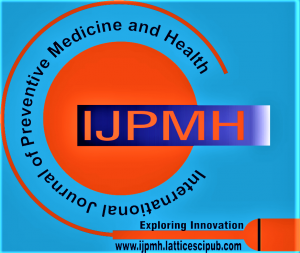![]()
Determinants of Anemia Event in Baby Age 6 Months in Jeneponto District
Nur Ulmy Mahmud1, Tahir Abdullah2, Arsunan, A.A3, Muhammad Syafar4, Veni Hadju5
1Nur Ulmy Mahmud, Public Health Deprtement, Universitas Muslim Indonesia, Makassar, Indonesia.
2Tahir Abdullah, Public Health Department, Hasanuddin University, Makassar, Indonesia.
3Arsunan, A.A, Public Health Department, Hasanuddin University, Makassar, Indonesia.
4Muhammad Syafar, Public Health Department, Hasanuddin University, Makassar, Indonesia.
5Veni Hadju, Public Health Department, Hasanuddin University, Makassar, Indonesia.
Manuscript received on 25 October 2020 | Revised Manuscript received on 04 November 2020 | Manuscript Accepted on 15 November 2020 | Manuscript published on 30 November 2020 | PP: 8-11 | Volume-1 Issue-1, November 2020. | Retrieval Number: A1001071120/2020©LSP
Open Access | Ethics and Policies | Indexing and Abstracting
© The Authors. Published by Lattice Science Publication (LSP). This is an open access article under the CC-BY-NC-ND license (http://creativecommons.org/licenses/by-nc-nd/4.0/)
Abstract: Anemia is a threat to global public health, especially in developing countries. The purpose of this study was to determine the determinants of anemia in infants aged 6 months. The research method used in this study is cross sectional study. The sample in this study was 68 infants in 6 sub-districts located in Jeneponto Regency, South Sulawesi. The selection of the subdistrict will be carried out based on an agreement with the Jeneponto Health Office with consideration of the performance of health workers in the Puskesmas, especially midwives and nutrition workers who oversee the sub-district so as to enable the implementation of this study properly. Measurement of levels of H b baby is done by sampling blood of babies at 6 months old baby is done by laboratory personnel who are already certified. Data analysis uses logistic regression. The results showed that the most sex is known in the sex of men who are not anemic that is about 51.6% and about 87.5% of babies get colostrum and as many as 81.3% are still breastfed until the age of 6 months, while for most birth weight in babies who are not anemic about 98.4% while for the length of the birth body the most is ≥48 cm (82.8%) . Identifying factors related to anemia, bivariate analysis was performed to select candidate variables to be included in multivariate regression showing that maternal age (p = 0.249) , family income (p = 0.051) , ANC (p = 0.094) , breastfeeding (p = 0.095) , birth weight (p = 0.063) and birth length (p = 0.158). The results showed that the determinant factor for the incidence of anemia in 6-month infants in Jenepon to District was birth weigh.t.
Keywords: Anemia, Birth Length, Birth Weight, Six Month old Baby.
